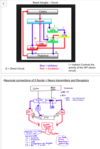Neuromotor L3 Flashcards
(61 cards)
______ (Large/small) alpha motor neurons innervate red fibres (small type I/slow twitch fibre)
Small Alpha
_____ (Large/small) Alpha motor neurons innervate type II (fast twitch) fibres
Large Alpha
_______ is a sign of chronic denervation (when one fibre dies the other one has to take up the territory that the one next to it that died innervated
Muscle fibre type grouping
What is muscle fibre type grouping?
a sign of chronic denervation (when one fibre dies the other one has to take up the territory that the one next to it that died innervated
What is a motor unit? What happens when a motor unit is denervated?
the one motor neuron to the number of muscle fibres it innervates (if the fibres next to it are denervated, it has to expand its territory to reconnect the innervated muscle fibres.
As a consequence, the motor unit expands and because fibre type is largely dictated by the type of neuron that connects to the muscle eg. slow motor neuron re- connecting to fast muscle fibres, then it would convert the fast muscle fibres to slow (vice versa))
What are the 2 mechanisms that postural adjustment is achieved by?
- Feed forward (anticipatory)
- Feed back (reflex) Requires post birth
What is the activity out of neurons within a deep cerebellar nucleus is governed by?
The activity out of neurons within a deep cerebellar nucleus is governed by (note if only had excitatory = no control) Purkinje neurons (will get inhibitory and excitatory inputs)
What is the major inhibitory neurotransmitter within the spinal cord?
Glycine
Explain how the knee jerk reflex is an example of reciprocal inhibition
Have post-synaptic gating and that neurons can be inhibited if they receive excitation from inhibitory neuron
Explain how motor unit expansion can lead to muscle weakness, poor control of movements and even muscle atrophy
In extreme cases where motor units are unable to reconnect to motor fibres
- Keeps expanding and expanding and then it can’t cope –> no longer able to expand
What are the motor areas of the cerebral cortex?

What is the primary motor cortex (PMA)?
Controls Simple Features of Movement

What is the pre-central gyrus?
- Somatopic representation of the body (body map)
- Cell bodies located in lamina V - Betz Cells
- Controls movts on opposite side of body
- Excitatory connections to a, g MNs and Ins
- Descending tract = CORTICOSPINAL tract. (Lateral Cortical spinal Tract, and Ventral Cortical spinal tract)
Disproportionate –> upper motor neuron pools are more in the hands and the face compared to the trunk and lower limbs • Have small muscle that control fine motor movements (eg. no gross movements like trunk ..etc) More weakness in large motor neurons because they are _____ (large/small) In small motor units, if the motor neuron dies then the one next to it can come with reconnection
large

What does the lateral cortical spinal track with direction connection to hand motor neuron muscle?

What does corticomotorneurons activate complex muscle patterns through divergent connections with spinal motor neurons that innervate different arm muscles?

How does Voluntary movement requires integration of all parts of the neuromotor system?

What is the pre motor cortex?
- 30% project to spinal cord (corticopsinal tract) & PMA
- To M1 region; some to spinal Inputs Sensory cortex and Visual feedback
- Neural activity before PMA (GET SET)
What is the function of the pre motor cortex?
setting up the motor programs for learned sequences, - coordination of bilateral MOVTS - active when told to dream movt
What is the lesion of pre motor cortex?
impaired ability to execute purposeful MOVTS
What is the function of the pre-motor cortex (lateral regions)?
Function thought be involved in the learning of the programmed sequences.
What are the different areas of cortex are activated during simple, complex and imagined Sequences of finger movements?

What happens to the cortex when looking, listening, speaking and thinking about words?

What are the speech centres and language disorders (aphasias)?











